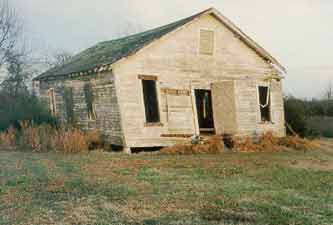
Church in Mississippi Delta
Sacred Spaces
The differences between churches in the South and North are often pointed out. The role of the church is perceived
to have changed from the South to the North. In the South, religion was believed to be more spiritual, whereas
the social service qualities of the church are emphasized in the North. Despite this change, the church remained
an important space for African Americans who migrated to Chicago. The rise of a huge number of storefront churches
in Chicago is generally thought to indicate a change in religious spaces from South to North. A more careful examination,
however, reveals that church space served a similar function in both the South and the North.
|
Church in Mississippi Delta |
In the South, churches usually had a small membership which allowed for intimate worship and relationships among members. The average country church was a small rectangular frame, with benches and a pulpit for the preacher. The accomodations were generally minimal. The physical conditions of the church were not important. The church simply provided a space for worship and for the development of relationships between members. It provided a space in the South where African Americans had a place and belonged. Members of the congregations had chairs in the church which were recognized as theirs. Thus, if they were missing from church, the congregation would know and the preacher would often go to their homes to make sure they were well. The church in the South provided an intimate and caring community for African Americans who were often faced by a harsh, uncaring community outside of the church. |
The church in the South also provided its members with a sense of ownership, a sense which they were denied throughout the South. Excluded from the educational, political, social, and economic circles of whites, the church was a space which was their own. It provided a space free from the oppressive conditions of everyday life. The church acted as the center of African American community life in the South.
| The church continued to be an important space for African Americans in Chicago. Upon arrival in Chicago, many migrants would join the large churches, such as Olivet Baptist or Quinn Church. These churches were spaces unlike those in the South. Quinn Chapel was built in 1891, by an African American architect and was the first African American church in Chicago. It started out as a non-denominational church, but later became associated with A.M.E.. The inside of the church is ornate and lavish and there is more emphasis on appearance than there was in churches in the South. A pipe organ was installed 1893. Stained glass windows, decorations, pews and all the furnishings were in place by 1898. These churches also acted as centers of the community in Chicago for many African Americans. Clergy members would often meet migrants at the train station, offering to clothe and feed them until they could do so for themselves. The churches provided special services for migrants, such as aid in securing a place to live and obtaining a job. Yet, once migrants settled, they often left these larger churches in order to join smaller, more intimate churches, similar to the churches they left in the South. |
The inside of Quinn Chapel www.tourblackchicago.com/quinn.htm |
|
Storefront Church on Chicago's South Side |
It was not only congregation members who migrated. Faced with dwindling membership due to the Great Migration, many miniters in the South would migrate with their congregation to the North. A church which also had an established in the South congregation in the South could be identified by the word "new" in the name. Once in Chicago, the congregations would would gather in homes to have prayer meetings. This intimate setting was appreciated by migrants who were used to the smaller churches of the South. Many of these prayer meetings would be attended by people from the same area in the South, sometimes even from the same community. Once these prayer meetings established a strong membership, they would set up a church in a storefront of a building. The storefront churches provided the barest essentials for worship. It would often be no more than chairs and an area where the minister stood. This arrangement is not, however, significantly different than the small churches in the South. |
| These storefront churches, then, served as the urban version of the small country church to which many migrants were accustomed. Storefront churches were not, however, simply a northern phenomenon. Many urban areas in the South also had storefront churches. The storefronts simply acted as a shell for African American religion as African Americans moved from place to place. Migrants created churches which were similar to the ones they left behind, and sought to locate the space with which they were familiar, the church, into the urban landscape. The vast number and variety of churches which developed in Chicago does not indicate a change in religion from South to North but rather a desire to worship in a similar style as in the South. Thus, the northern church continued to provide a space for African Americans where they were cared for and were part of a community free from the oppression of whites. |
Storefront Church in Mississippi |
|
|